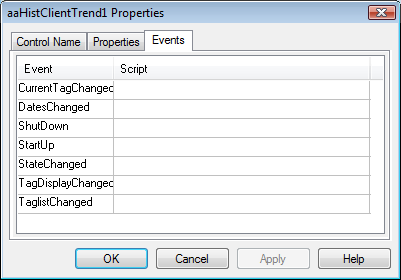Topic 6.1.1 – Overview
Introduction
ActiveX controls can run in any application that functions as a .NET or an ActiveX container, such as InTouch HMI software, Visual Basic, Visual C++, web pages, and so on. The controls can also be selected from within InTouch WindowMaker when you create an InTouch Runtime graphical user interface.
The Wonderware Historian Client objects and controls must be installed on the computer running the application that you want to use them in. For example, if you want to use the aaHistClientTrend control in InTouch HMI software, you must install the trend files on the InTouch computer.
aaHistClientTrend and aaHistClientQuery are high-level controls used for trending tag values and building SQL queries from within the ActiveX container applications.
The aaHistClientActiveDataGrid control can execute any SQL query that returns a result set from any Wonderware Historian Server or Microsoft SQL Server database and returns the results in a grid.
All ActiveX controls must be installed on the computer running the application. For example, if you want to use the aaHistClientTrend control in InTouch, you must install the aaHistClientTrend files on the InTouch node.
Internet Use
Technically, the ActiveX versions of the controls can be used within Internet Explorer. However, because Internet Explorer is a native .NET control container, use the native controls instead of the ActiveX versions.
Many ActiveX controls can be used on Active Server Pages (ASP) and used to retrieve data from an Historian Server over the Internet.
ASP is a technology made available by Microsoft Internet Information Server (IIS). ASP pages are files that contain HTML tags, text, and script commands and can call COM components to perform tasks.
For more information on ASP, refer to the Microsoft documentation.
Wonderware Historian Server incorporates a three-tiered client/server ActiveX framework that supports Internet-enabled applications. It is possible to deploy a global and robust Internet/intranet solution across factories in different parts of the world with the same level of data integrity and security of a local network.
Historian ActiveX Framework
The three-tier architecture consists minimally of a client, one or more data sources (such as InTouch or DA/IO Servers), and one Historian Server database. A typical installation is composed of a number of computers on each of the three tiers. Typically, these computers are networked via a TCP/IP connection.
Wonderware Historian Client ActiveX controls are fully integrated with InTouch, I/O Servers, and other Wonderware products components and provide unlimited scalability.
ActiveX Controls and InTouch
InTouch is an ActiveX control container. This means that it is capable of hosting ActiveX controls. Before any ActiveX control can be used in InTouch, it must be installed.
You must assign InTouch tag names to the properties of a control. A property must be assigned to the equivalent InTouch tag name type. For example, a message property must be assigned to an InTouch message tag name. Although you can use the Properties dialog box to assign tag names to properties, it is easier to set the properties directly through QuickScripts.
For events, if the window containing a control is closed, its event scripts and any other InTouch QuickScripts containing script functions associated with that control do not execute properly
Common Properties, Methods, and Events
There are three main aspects of ActiveX controls: properties, method, and event.
Properties
Properties are attributes of the ActiveX control that you can set. For example, a property can control what background color is used for the trend chart in the trend control.
Method
A method performs a function for an ActiveX control. For example, a method can set the time span for the query.
Event
An event is an occurrence of something within or to the ActiveX control, such as a mouse click or a data change that you might want to respond to through scripting (known as an event handler).
Configuring Properties
Each ActiveX control’s Properties tab displays four columns: Property, Range, Tag Type, and Associated Tag. The Property and Range columns are read-only. The Associated Tag column is used to associate InTouch tag names with the respective property in the Property column.
Note: Many users of other control containers become confused by the Properties dialog box.
This dialog box cannot be used to set the properties of the control at design time.

Using Events
Events are accessed through InTouch scripting and other InTouch QuickScripts.
In order for an ActiveX event script to function properly, the ActiveX control for which the script was created must be loaded into the memory.
If the window containing an ActiveX control is closed, its ActiveX event scripts and any other InTouch QuickScripts containing script functions associated with that ActiveX control will not
execute properly.

Note: Each control has unique configuration options.
